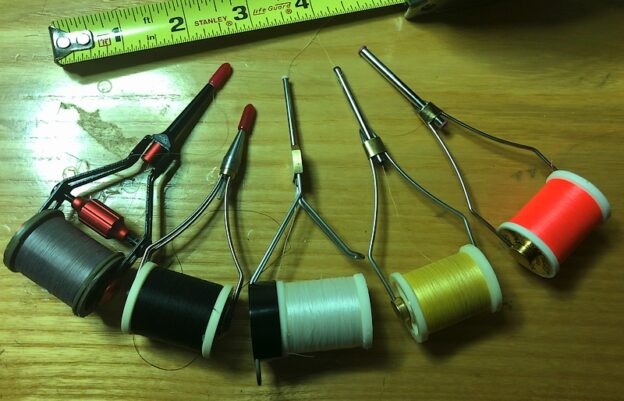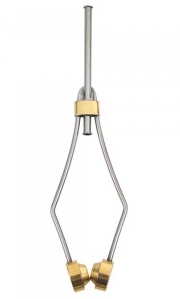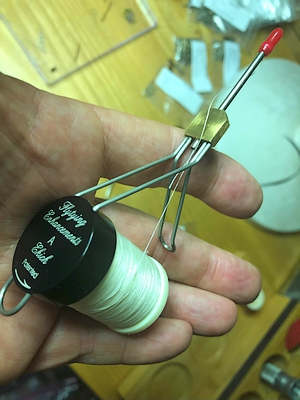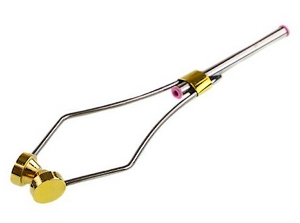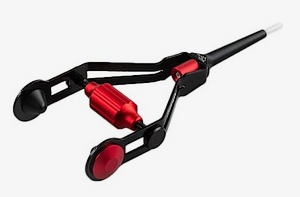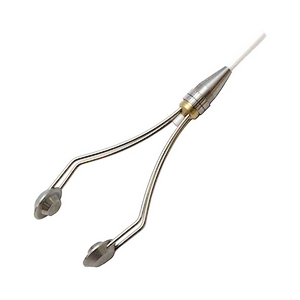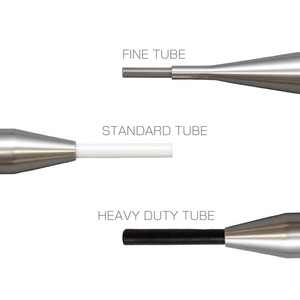In Part 1 of this post we reviewed a mix of high priced engineering marvels leavened with a few of the lower cost traditional bobbins. The hope is with the increased cost of some bobbins comes a variety of new capabilities and features, rather than simply increased cost for the same feature set found in less expensive options.
In Part 2 we’ll extend our earlier efforts onto a new crop of bobbins, some expensive, others less so, in the hope we can find evidence of bobbins evolving into something more, other than simply high priced gadgetry.
As with the first post, we’ll use the same series of simple tests for each bobbin; different threads, different flies tied – some large, some small, the ability to fit different thread spool sizes, loading the bobbin via mouth, thread management – if offered, and evaluate any unique new features on the bobbin not shared by the rest of the group.
Option 6: Dr Slick ECO Bobbin BOB4
Barrel Length: 1.75″
Overall Length: 4.5″
Cost: $7 – $10
The Dr Slick BOB4 bobbin is a simple recreation of the original Matarelli bobbin, with a dual “glass” barrel insert. There is no explanation on the maker’s website as to the “dual” designation, so I’ll assume the dual “glass” inserts imply an insert in the top and a second insert at the bottom of the barrel … versus a single insert extending through the barrel.
It is listed as a 4″ bobbin, and is 4.5″ from glass tip to bottom of thread spool when loaded.
This bobbin performed all tasks admirably, with no issues. Construction seemed solid, spool tension was adequate, and the only visceral reaction I had to the bobbin was the color of the glass insert. Both tip and bottom are black – which made the thread hole appear small and hard to find, especially if you’re loading black thread. The air flow seemed less when sucking the thread through, as if the hole were smaller than other bobbins, even though the barrel is wider than most. I was able to consistently load the bobbin via mouth, so the functionality was intact.
Thread tension, and thread management, is via “spreading the legs” of the bobbin forcibly, identical to a Matarelli bobbin, and the polished brass feet gave a consistent feel and provided smooth resistance to thread leaving the barrel.
This is a long tube bobbin. The overall barrel width is wider than most as it will not fit a 14 gauge needle scabbard, you will need to purchase a larger gauge if you employ them to protect your bobbins.
In short, this is a good quality, functional long tube bobbin, no frills or features, and is a good replacement candidate for the cost concious angler learning to tie flies and intent on possessing several more of these.
Bobbin: 4 Stars. No additional features outside of those consistent with the traditional Matarelli bobbin. A ceramic or “glass” sleeve is a common feature of today’s bobbins, so it is not considered unique for this test.
Option 7: Ekich Bobbin
Barrel Length: 1.75″
Overall Length: 4.25″
Cost: $140 – $150
New Feature: Thread Management
The Ekich bobbin has been around for a decade or so, and is likely the last word in thread management for fly tying bobbins. The marvel is the brainchild of Faruk Ekich of Canada, and his company, AutomaticBobbin.com.
This bobbin approaches thread management in a different way than spool brakes or simple tensioners, rather the focus is on both thread payout and recovery, versus simply making a spool brake to increase the tension on the spool.
The Ekich bobbin features a coiled spring that tightens as small amounts of thread are pulled from the spool, allowing this coiled energy to recover thread back onto the spool should slack appear in the thread via a user’s manipulation of the bobbin. The bobbin is precisely architected to provide about 33 grams of resistance to hold the bobbin and thread spool at the position of last use, and requires tension control of the thread via the user’s fingers on the spool, versus any mechanical tension adjustment. As the spring coils the bobbin can be moved toward the work area to recover thread back onto the spool.
This bobbin requires a little getting used to on the part of the user, and is the most expensive bobbin currently offered on the market, so you need to approach this knowing there is a bit of a learning curve, and significant costs are involved.
All fly tying bobbins have been engineered to dispense thread and the Ekich bobbin is engineered to dispense, and recover thread, which sets it apart from the rest of the pack. The small spring and its coiled energy can be used to recover thread, tighten half hitches, and plague the owner repeatedly when he forgets to release the pent up energy and cuts the thread when the fly is complete. The coiled spring immediately sucks the thread back through the barrel and you have to reload the bobbin over and over until you learn this lesson properly.
Spring energy can be dissapated simply by lifting the spool away from the spool housing with thumb and forefinger to allow the small peg on the housing to clear the thread spool, and it will immediately release all its stored energy. This peg fits inside the thread spool recesses and winds the spring as the spool is rotated dispensing thread. It has a 24″ capacity, so once 24 inches of thread has been pulled from the bobbin, tension changes markedly queing you to release the coiled spool. Note that wooden spools cannot be used on the Ekich bobbin as they lack holes in their surface that can engage this small peg. A few other spool types have minor issues, and notes can be found on the maker’s website for both workarounds and probibitions.
Bobbin function is admirable, with no issues on simple tasks. Loading thread via mouth worked well, the fit in the hand, including one handed operation of the “spool lift” to release spring tension, also worked flawlessly, the frustration associated with having the thread pulled back through the thread barrel on fly completion is completely mental … “old dude forgetfullness”, not a function of the mechanics of the bobbin.
I tested the trout model and it was NOT a long tube bobbin. The maker makes a Salmon model with a slightly longer tube (30mm versus 20mm for the trout size) that approximates the long tube style. This bobbin does not allow midge spools as they are too short to engage the rubber “O” ring, and midge spools lack the proper hollowed area to allow the spring peg to fit within them.
I tied large flies and small with the trout model and felt the 33g of precision control both a blessing and a curse. For small dry flies and nymphs the bobbin performed well until you approached the coiled spring limit of 24 inches of dispensed thread. At that juncture tension increased and it seemed prudent to release the coiled energy by lifting the bobbin up the spindel with thumb and forefinger, making the extra tension disappear and allowing additional work. This was an extra step not required of any other bobbin, and it was wasteful. The tension abruptly resets to 33g and it will seem suddenly sloppy-loose – compared to a moment ago.
As a fast moving, former commercial tyer, I am judgemental over wasted energy and unecessary steps, and I did not care for the required spring-coil adjustments. This is not something insurmountable, this is part of the “getting used” to this particular bobbin and its unique foibles.
On large flies and heavy threads, 33g was much too loose. Tying a big saltwater fly requires constant tension and pressure given how the amount of mats and their control can often be unruly. Resetting the bobbin tension to 33G under these conditions was a pain, something I did not like. The now relaxed tension was much too loose for the large fly and materials I was adding, and I immediately had to clamp down on the thread spool to avoid unwanted thread payout – especially as there are no warnings when you’re about to hit the 24″ dispensed thread boundary.
I did not find any information suggesting the Salmon size bobbin had a different tension value, so I have to assume it’s set for the same 33G as the trout model. This is great for 18/0 midge thread, but doesn’t work as well for Size “A” and a fistful of bucktail.
This bobbin might be well suited for specific types of fly, as I tested with the trout size and felt it worked best with small flies. The cost of the thread management is prohibitive in my mind, so I was not prepared to immediately purchase the larger Salmon model to see if it was better suited for the larger flies.
In summary, a good bobbin with unique features that require the user to adjust their tying style – instead of simply use. Bobbin: 3 stars, as the tension felt too weak to tie large flies, and the constant release of pent up energy was a wasteful step, that I often forgot. New Feature: Thread Management: 3 Stars. The thread management worked well dispensing and recovering thread, but the tension was constantly needing assistance from my fingers, even when my fingers were busy releasing coiled energy from the spring. The cost of this bobbin will make it prohibitive to own six or seven of them, so specific uses may make this bobbin more attractive to own compared to general fly tying. This is not a bobbin for a well heeled beginner to own, rather it’s a unique use bobbin for an experienced tier with specific demands. Good bobbin, excellent construction, with foibles … and a nosebleed price for thread management.
Option 8: Hareline Double Ceramic Premium Bobbin
Barrel Length: 1.75″
Overall Length: 4.5″
Cost: $11 -$15
The Hareline Double Ceramic fits a midge spool right out of the box, so I’ll assume that will loosen over time if using standard size spools. This is another Matarelli bobbin replacement, with only the ceramic insert to offer new functionality over the aging Matarelli standard.
This bobbin has the largest tube diameter of all those tested, and coupled with the traditional flaired ceramic cap will not fit a traditional 14 gauge needle scabbard cover. The inside diameter of the barrel is also larger than all others tested, so it should work quite well dispensing thin yarn or floss in addition to thread.
Not surprisingly, this is really easy to thread and the easiest bobbin to load with simple suction, given how much oxygen can be pulled through the barrel.
The ceramic material lining the barrel is the “roughest” tested – imparting a noticeable “grating: feel to the thread as the bobbin rotated around the hook shank. While disconcerting, as I’m used to silky smooth ceramic and stainless barrels, this did not actually grate on the thread, it felt that way. Occasionally I would hear an audible sound when winding, suggesting it wasn’t just my imagination as to the “rough” surface. Note that I use quotes when describing “rough”, the barrel is not rough nor did it sever thread or wear it in the slightest, it simply felt like it was destroying the thread, and didn’t actually harm it at all. Of all the bobbins tested this was the only ceramic that had this feel.
Bobbin: 4 Stars. No new features, a solid Matarelli replacement in a long tube design, that due to the barrel inside diameter should be considered for dispensing more than thread. This would be excellent for fine yarns and floss.
Option 9: SMHAEN Bobbin
Barrel Length: 2″
Overall Length: 4.25″
Cost: $65 – $85
New Feature: Thread Tensioning
The bobbin comes in two flavors; the red version of the SMHAEN is standard length and the blue is their midge version. Due to the constraints inherent in the design there is little ability to fit differing spools sizes due to the legs of the bobbin being joined by the tension adjusting arm. Not surprisingly it would not fit a midge spool in the standard model.
I purchased the standard version hoping it was closer to the long tube I was looking for, and like many of the other makers, the SMHAEN standard version is midway between a Matarelli standard and a Matarelli Long Tube bobbin.
The new feature available is thread tensioning adjustment, likely the largest range of adjustment currently offered in bobbins. The Matarelli relies on pressure from the bobbin legs, the Stonfo and Petitjean offer small adjustments via a tensioning slider, and the SMHAEN gives you a true thread brake, allowing you to lock the spool into an unusable configuration for light threads.
Upward movement on the tension adjustment (clockwise) tightens the thread, and downward movement of the knob loosens the thread. As the tensioner knob is available while gripping the bobbin you can adjust thread tension on the fly, in an intuitive and hand-friendly manner.
The SMHAEN has a prohibition on using Kevlar thread in the bobbin, so please note that its use may invalidate any warranty.
Bobbin operation was silky smooth. Thread can be sucked through the barrel and the bobbin loads easily via mouth. It has the thinnest ceramic insert of any of the bobbins tested and fits a 14 gauge needle scabbard perfectly. This fine tip is worth protecting with a needle scabbard as its thinness could be considered downright “sharp” if the ceramic chipped or cracked. I’m unwilling to test the ceramic inserts strength given smashing an $80 bobbin strictly for science is not my cup of tea.
Because of the design of the bobbin, its feet move the least of all the bobbins tested, and any variation in spool sizes may be an issue. This same tensioning arm configuration also means that changing spools takes three times longer than any other bobbin, as the adjustment knob has to be loosened to the point where the old spool can be removed, the new spool inserted, and then retensioned to the desired setting. This is a manual and cumbersome process compared to other bobbins, so frequent thread changes are undesirable.
This is a solid bobbin, pricey, but effortless to use outside of the spool changing issue. The ceramic barrel may be fragile due to the thinness of its walls, but this issue may require extended use and more opportunity for mishap, like dropping a pedastal base onto the bobbin while its resting on the table.
Bobbin 4 Stars. New Feature: 4 Stars if thread changes are infrequent, 3 Stars if you change thread spools often.
Option 10: Tiemco Adjustable Barrel Double Arm Bobbin
Barrel Length: 1.5″
Overall Length: 3.75″ to 4.5″
Cost: $34 – $85
New Feature: Adjustable Barrel Length
My compliments to the designer as they were able to devise functionality never seen in a bobbin that I didn’t know I needed …
That’s saying something.
The double feet on the bobbin did not move the needle for me, in fact I found them a liability in an unlikely manner. When threading a traditional bobbin you have to negotiate the thread past the two feet and into the barrel. With a double foot bobbin, you have FOUR wires in the way, and threading is a bit more of an issue. Four wires provides a bit more resistance to the thread spool, but I can’t say it was noticeable when using the bobbin.
The aparture for the barrel is quite small, as is the ceramic tube itself. It was easy to load the bobbin via mouth, but the four feet (four wires in the way) and small opening had me looking for reading glasses to assist the threading process.
What was a major change was the adjustable barrel, and how I no longer cared whether I had a midge, standard, or long tube flavor, as all those bobbins were available within this single chassis.
WInner, Winner, Chicken Dinner…
The bobbin barrel adjustment is identical to mounting a bit into a power drill. Tighten or loosen the cap, adjust the barrel to the length desired, then retighten the barrel housing to fix the barrel at that length. This adjustment can be made with the bobbin hanging from the fly as well as on the workbench. This functionality is immediately useful and can be used on nearly every fly tied. Adjusting the bobbin barrel length to your favorite setting, and tie with abandon on big, small, complex, or dainty.
The ceramic barrel, barrel housing, and chassis can be disassembled into three pieces. The barrel itself is 1.5″ long, so you can adjust the bobbin length about an inch comfortably. There is a minimum amount of ceramic barrel that must remain in the barrel housing to ensure a good fit and initial experimentation suggests it’s about half an inch of barrel that must stay in the tube to engage the mechanism properly.This gives you an inch of barrel to move in either direction.
Barrel fully extended the bobbin is about 4.5 inches long, with barrel retracted, the bobbin is about 3.75 inches long.
The ceramic barrel has a small diameter and as the barrel is extended, is at increased risk for a potential impact break. Tying at a show and dropping it into a backpack might expose it to a pedastal base impact as you add a vise, and while the ceramic barrel is a cinch to replace, I don’t see the vendor selling replacement barrels. This might mean the ceramic will never break, or it may mean you might have to learn to retract the barrel before storage in your tool caddy or backpack. The ceramic barrel is too small for a 14 gauge needle scabbard, but retracted, the housing accepts that size perfectly. I want to protect ceramic where possible, so this is becoming increasingly non-trivial.
For some reason Amazon is selling these at half price from a vendor in Japan. I bought mine for $34 thinking it was retail, and find all the shops in the United States are selling it for $80. Three different barrels are available on the bobbin, fine, standard, and heavy duty, but I only see the standard weight barrel available via fly shops.
I am going to purchase a couple more while Amazon has them at the lower price, just to ensure I have several.
Bobbin: 4 Stars. New Feature: 4 Stars. Really nice bobbin, well made and easy to use. New features operate intuitively, making it easy to assimilate them into your tying on the first fly. Really expensive bobbin so jump on the Amazon price while they still have a few. I hope this barrel technology will be used by other manufacturers versus making multiple bobbin lengths. Vendor needs to sell additional barrels so you can swap or replace your barrel.
Bobbin Summary
Over the course of these two posts we’ve seen only four areas of change in bobbins. Thread Management, Thread Tensioning, adjustable barrels, and the addition of a dubbed loop capability, everything else is the same feature set as the original Matarelli bobbin, with a few material changes to the bobbin chassis, like ceramic barrels. While some of the bobbins showed merit, some were easy to use, some required relearning a thing or two, and some were downright silly, several of the technologies hold promise.
As there are more than a single type of fly tyer, and many types of flies, different functionality may appeal to some versus others. Thread management is low on my list, thread tensioning a bit higher, but outside of the moveable barrel on the Tiemco, none of these are about to topple the low cost Matarelli type bobbins from their well earned throne.
Engineering marvels, all … and beastly expensive in light of what you get.
Hopefully you found a few questions answered without having to purchase all these costly bobbins. As always, I paid retail for all of the bobbins in both articles, with an emphasis on all bobbins boasting of new functionality (and nosebleed cost). In my mind, only the Tiemco offered a mature technology to me immediately, with the Petitjean … a glimpse of future function.
For the beginning fly tier, stick with the inexpensive bobbins for the moment. Changes to bobbin technology are in their infancy and the large dollar outlay is not warranted at the moment. As with fly rods, fly reels, and everything else in our sport, wait until your skills outclass your equipment before you plunk down the big dollars for bobbins (or anything else in our sport).
Disclaimer: As always I have paid full retail for all the bobbins reviewed above. This ensures cost is factored into the features reviewed, and my righteous indignation crops up appropriately at the precise moment needed.

